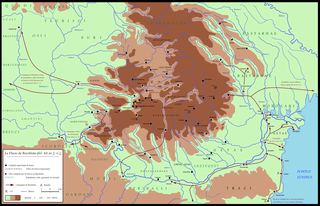
The Cimmerians were an ancient Eastern Iranic equestrian nomadic people originating in the Pontic–Caspian steppe, part of whom subsequently migrated into West Asia. Although the Cimmerians were culturally Scythian, they formed an ethnic unit separate from the Scythians proper, to whom the Cimmerians were related and who displaced and replaced the Cimmerians.

The Thracians were an Indo-European speaking people who inhabited large parts of Southeast Europe in ancient history. Thracians resided mainly in Southeast Europe in modern-day Bulgaria, Romania, N. Macedonia and northern Greece, but also in north-western Anatolia in Turkey.

The Thyni were a Thracian tribe that lived in south-eastern Thrace. The Thyni were closely related to the Bithynians, with whom they often exchanged troops and royal marriages, later a section of the Thyni, along with the Bithyni, migrated to the area in Asia Minor that would later be known as and Bithynia, and where they would later be conquered by the Lydian and Persian empires. Each respective region got its name, presumably, from the Thracian tribe that was more prominent in the area. Xenophon praises the Thyni: "Teres, with a large army, was said to have had his baggage train taken from him by the natives, who are called Thyni and are supposed to be the most dangerous of all the tribes, especially at night fighting." The Thyni included clubs amongst their weapons. The Thyni often joined the ranks of organized armies as mercenaries or volunteers.

The Maedi were a Thracian tribe in antiquity. Their land was called Maedica (Μαιδική). In historic times, they occupied the area between Paionia and Thrace, on the southwestern fringes of Thrace, along the middle course of the Strymon, between the Kresna Gorge and the Rupel Pass. Strabo says that the Maedi bordered eastward on the Thunatae of Dardania, and that the Axius flowed through their territory.
Madyes was a Scythian king who ruled during the period of the Scythian presence in West Asia in the 7th century BCE.
Koilaletoi or Coilaletae or Coelaletae is the name of a Thracian tribe. Other parts of this tribe were, the Coelaletae Maiores and Coelaletae Minores. They are mentioned by Tacitus.
Dugdammî or Tugdammî, also known by the Greeks as Lygdamis and Dygdamis, was a Cimmerian king of the mid-seventh century BC.
Sandakshatru or Sandakuru was the last known Cimmerian king.

The Serdi were a Celtic tribe inhabiting Thrace. They were located around Serdica, now Sofia in Bulgaria, which reflects their ethnonym. They would have established themselves in this area during the Celtic migrations at the end of the 4th century BC, though there is no evidence for their existence before the 1st century BC. Serdi are among traditional tribal names reported into the Roman era. They were gradually Thracianized over the centuries but retained their Celtic character in material culture up to a late date. According to other sources they may have been simply of Thracian origin; according to others they may have been of mixed Thraco-Celtic origin.

Tilataei is the name of a Thracian tribe that was located in Serdica. They are mentioned by Thucydides.
Crousi is the name of a Thracian tribe. They are mentioned by Dionysius of Halicarnassus.
Krobyzoi is a Thracian, Getic or Dacian tribe.
The Treres were a Thracian tribe, of whom a part invaded Anatolia in the 7th century BCE, while another part lived in Thrace and Illyria.

The Terizi were a Thracian Getic tribe. The Terizi lived on the Tirizian promontory.

The Scaugdae were an ancient people living between the Haemus Mountains and the Danube river. They are known from only one passage from Pliny the Elder's Naturalis Historia, where he mentions them alongside the Aedi and Clariae as the neighbours of the Getae.

The Clariae were an ancient people living between the Haemus Mountains and the Danube river. They are known from only one passage from Pliny the Elder's Naturalis Historia, where he mentions them alongside the Aedi and Scaugdae as the neighbours of the Getae.

The Aedi were an ancient people living between the Haemus Mountains and the Danube river. They are known from only one passage from Pliny the Elder's Naturalis Historia, where he mentions them alongside the Clariae and Scaugdae as the neighbours of the Getae.
Išpakāya was a Scythian king who ruled during the period of the Scythian presence in Western Asia in the 7th century BCE.






